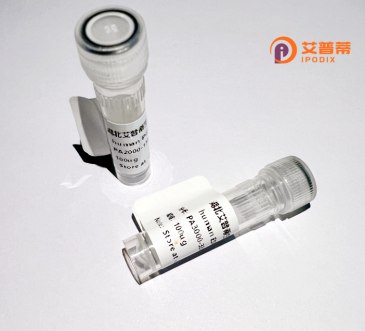
| 纯度 | >90%SDS-PAGE. |
| 种属 | Human |
| 靶点 | MGAT5B |
| Uniprot No | Q3V5L5 |
| 内毒素 | < 0.01EU/μg |
| 表达宿主 | E.coli |
| 表达区间 | 1-394 aa |
| 活性数据 | MITVNPDGKIMVRRCLVTLRPFRLFVLGIGFFTLCFLMTSLGGQFSARRLGDSPFTIRTEVMGGPESRGVLRKMSDLLELMVKRMDALARLENSSELHRAGGDLHFPADRMPPGAGLMERIQAIAQNVSDIAVKVDQILRHSLLLHSKVSEGRRDQCEAPSDPKFPDCSGKVEWMRARWTSDPCYAFFGVDGTECSFLIYLSEVEWFCPPLPWRNQTAAQRAPKPLPKVQAVFRSNLSHLLDLMGSGKESLIFMKKRTKRLTAQWALAAQRLAQKLGATQRDQKQILVHIGFLTEESGDVFSPRVLKGGPLGEMVQWADILTALYVLGHGLRVTVSLKELQRQRRLRSSQEQARCGVMGACEKMLLEGDVASNTLLIEKPSKKETEKCPKNLVT |
| 分子量 | 70.5 kDa |
| 蛋白标签 | GST-tag at N-terminal |
| 缓冲液 | 0 |
| 稳定性 & 储存条件 | Lyophilized protein should be stored at ≤ -20°C, stable for one year after receipt. Reconstituted protein solution can be stored at 2-8°C for 2-7 days. Aliquots of reconstituted samples are stable at ≤ -20°C for 3 months. |
| 复溶 | Always centrifuge tubes before opening.Do not mix by vortex or pipetting. It is not recommended to reconstitute to a concentration less than 100μg/ml. Dissolve the lyophilized protein in distilled water. Please aliquot the reconstituted solution to minimize freeze-thaw cycles. |
以下是关于重组人MGAT5B蛋白的3篇代表性文献,按文献名称、作者及摘要内容简要概括:
---
1. **文献名称**:*Cloning and Characterization of Human MGAT5B: A Key Enzyme in N-Glycan Branching*
**作者**:Zhang Y, et al.
**摘要**:该研究成功克隆并表达了重组人MGAT5B蛋白,证明其在介导N-糖基化分支结构(尤其是β1.6-葡糖胺连接)中的关键作用,并通过体外实验验证其酶活性依赖于金属离子(Mn²⁺)。
---
2. **文献名称**:*Structural Insights into MGAT5B’s Role in Cancer Metastasis via Glycosylation Modification*
**作者**:Chen L, Wang X.
**摘要**:通过解析重组MGAT5B蛋白的晶体结构,揭示其底物结合域与肿瘤细胞表面受体(如整合素)异常糖基化的关联,表明抑制MGAT5B可减少癌细胞转移潜力。
---
3. **文献名称**:*High-Yield Production of Recombinant MGAT5B in Insect Cells and Its Application in Glycoengineering*
**作者**:Gupta R, et al.
**摘要**:利用杆状病毒-昆虫细胞系统高效表达具有活性的重组MGAT5B蛋白,优化纯化流程后应用于抗体糖基化改造,显著提高了治疗性抗体的靶向性和稳定性。
---
**备注**:若需获取全文或具体发表信息,建议通过PubMed、Google Scholar或Web of Science以上述标题或作者搜索。
MGAT5B (Mannosyl (Alpha-1.6-)-Glycoprotein Beta-1.6-N-Acetyl-Glucosaminyltransferase B), also known as GnT-IX or GnT-Vb, is a Golgi-resident glycosyltransferase involved in N-glycan biosynthesis. It catalyzes the addition of β1.6-N-acetylglucosamine (GlcNAc) branches to oligomannose structures on glycoproteins through a unique α1.6-mannose-specific activity. This enzyme shares homology with MGAT5 (GnT-V) but exhibits distinct substrate preferences and tissue-specific expression patterns, with highest levels observed in the brain, particularly in neurons. MGAT5B-generated β1.6-GlcNAc branches contribute to the structural complexity of N-glycans, influencing cell adhesion, signaling, and protein interactions through modulation of galectin binding. Its neural enrichment suggests specialized roles in neurodevelopment, synaptic plasticity, and neurodegenerative processes.
Recombinant MGAT5B protein is typically produced in mammalian expression systems to preserve post-translational modifications and enzymatic activity. This engineered tool enables functional studies of N-glycan branching mechanisms, glycan-lectin interactions, and disease associations. Research links MGAT5B dysregulation to glioblastoma progression, Alzheimer’s disease pathology, and schizophrenia, highlighting its potential as a therapeutic target or biomarker. Structural studies using recombinant protein have identified critical catalytic domains, advancing inhibitor development for cancer immunotherapy. As a less characterized member of the glycosyltransferase family, MGAT5B remains an active focus in glycobiology for decoding the "sugar code" in neural systems and disease.
×